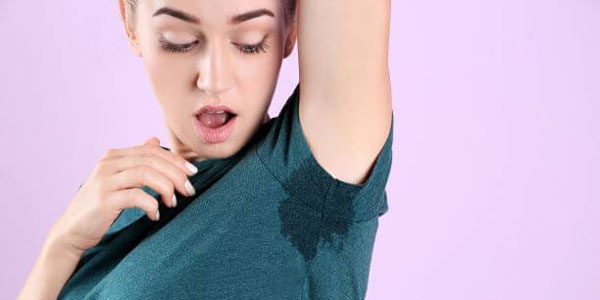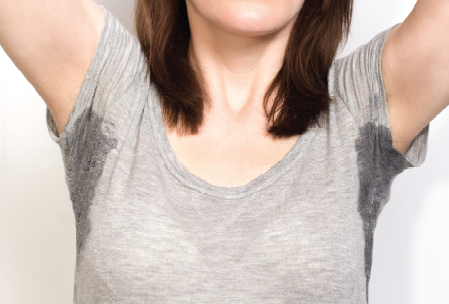
You've already gotten dressed for the day, but it's only a matter of time until the sweat from your armpits soaks through your shirt, requiring you to make a hasty wardrobe adjustment. That is how it feels when your underarms sweat excessively, a condition referred to as axillary hyperhidrosis after its medical term. Even while sweating is a natural way for your body to cool down, excessive sweating may substantially interfere with a person's ability to go about their everyday life. Excessive sweating produces four times the quantity required for your body to maintain a constant temperature, according to Adam Friedman.
What You Should Know About Glands That Produce Sweat
The body's sweat glands are in the armpits, soles of the feet, palms of the hands, forehead, and cheeks, as stated by the International Hyperhidrosis Society (IHS).
The bulk of these glands is called "eccrine" sweat glands, responsible for producing an odorless, colorless fluid that assists in cooling the body. In hyperhidrosis, the sort of sweat that most often manifests itself is that which is generated by the eccrine glands.
What Is Axillary Hyperhidrosis, And What Factors Lead To The Development Of This Condition?
Primary axillary hyperhidrosis is a disorder that describes excessive sweating beneath the arms that is not brought on by another medical disease. Even though physicians are unsure of what precisely causes it, they know how the condition manifests inside the body. According to Dr. Friedman, "what's occurring is that the neurons that provide signals to the sweat glands [which instruct them] to sweat are hyperactive." According to the IHS, your sweat glands react differently to different stimuli. These are the following:
- Signals from your brain that your body's temperature is rising over normal hormones and emotions
- The activity of a physical nature or exercise
According to the International Hyperhidrosis Society (IHS), patients with hyperhidrosis have sweat glands that respond to these instructions by generating excessive sweat. Dr. Friedman points out that hyperhidrosis tends to run in families; however, researchers have not successfully identified the genes linked to the disorder.
Who Develops Axillary Hyperhidrosis?
According to Dee Anna Glaser, MD, a dermatologist at SLUCare Physician Group in St. Louis, the majority of persons who have underarm sweating begin experiencing it after puberty, throughout adolescence or in their early teens, and often before the age of 25, she adds.

According to the International Hyperhidrosis Society (IHS), some individuals with axillary hyperhidrosis may only experience excessive sweating in their underarms. However, the condition can also manifest itself in other areas of the body, including the hands, feet, face, scalp, or groin in other cases. Additional symptoms of primary hyperhidrosis include the following:
- Excessive perspiration on at least one occasion every week for at least six months
- Experiencing sweat on both sides of the body (meaning not just one underarm, but both)
- Having excessive sweating to the point that it interferes with your regular activities
Does Sweating In The Armpits Indicate Generalized Hyperhidrosis?
Primary hyperhidrosis affects most individuals with excessive sweating from their armpits; however, it is also possible for people to have sweaty armpits due to generalized hyperhidrosis, also known as secondary hyperhidrosis.
According to Elizabeth Jones, "both primary and secondary hyperhidrosis may develop to axillary hyperhidrosis." Secondary hyperhidrosis often causes bilateral armpit sweating, according to Dr. Jones. "However, some individuals have a tendency to sweat more on one side, and as a result, many perceive it more in one armpit," he adds.
The Treatment of Axillary Hyperhidrosis
The International Hyperhidrosis Society (IHS) reports a variety of possible therapies for axillary hyperhidrosis. Since excessive sweating may have severe effects on your social, emotional, and physiological well-being, Dr. Glaser advises patients to seek a second opinion if their primary care physician tells them, "Don't worry about it, there's nothing we can do about it, and it's not going to kill you." She advises scheduling an appointment with a dermatologist to collaborate on a treatment plan.

Antiperspirants
According to the International Hyperhidrosis Society (IHS), antiperspirants are frequently the first therapy physicians would employ to treat axillary hyperhidrosis. This is because antiperspirants are the least intrusive treatment and are affordable. When antiperspirant is applied to a particular place, the sweat in that region clings to it and pulls the antiperspirant particles deeper into the skin's pores. This causes the sweat ducts to "plug," which tells your brain to cease delivering impulses to sweat in that location. As a result, you will experience less sweating.



